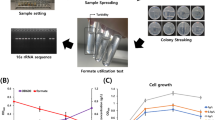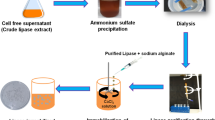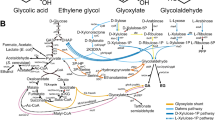Abstract
Nicotinamide adenine dinucleotide phosphate-dependent 7α-hydroxysteroid dehydrogenase (7α-HSDH) and 7β-hydroxysteroid dehydrogenases (7β-HSDH) from Clostridium absonum catalyze the epimerization of primary bile acids through 7-keto bile acid intermediates and may be suitable as biocatalysts for the synthesis of bile acids derivatives of pharmacological interest. C. absonum 7α-HSDH has been purified to homogeneity and the N-terminal sequence has been determined by Edman sequencing. After PCR amplifications of a gene fragment with degenerate primers, cloning of the complete gene (786 nt) has been achieved by sequencing of C. absonum genomic DNA. The sequence coding for the 7β-HSDH (783 nt) has been obtained by sequencing of the genomic DNA region flanking the 5′ termini of 7α-HSDH gene, the two genes being contiguous and presumably part of the same operon. After insertion in suitable expression vectors, both HSDHs have been successfully produced in recombinant form in Escherichia coli, purified by affinity chromatography and submitted to kinetic analysis for determination of Michaelis constants (K m) and specificity constants (k cat/K m) in the presence of various bile acids derivatives. Both enzymes showed a very strong substrate inhibition with all the tested substrates. The lowest K S values were observed with chenodeoxycholic acid and 12-ketochenodeoxycholic acid as substrates in the case of 7α-HSDH, whereas ursocholic acid was the most effective inhibitor of 7β-HSDH activity.






Similar content being viewed by others
References
Akao T, Akao T, Kobashi K (1987) Purification and characterization of 7β-hydroxysteroid dehydrogenase from Ruminococcus sp. of human intestine. J Biochem 102(3):613–619
Baron SF, Franklund CV, Hylemon PB (1991) Cloning, sequencing, and expression of the gene coding for bile acid 7a-hydroxysteroid dehydrogenase from Eubacterium sp. strain VPI 12708. J Bacteriol 173:4558–4569
Bennett MJ, McKnight SL, Coleman JP (2003) Cloning and characterization of the NAD-dependent 7α-hydroxysteroid dehydrogenase from Bacteroides fragilis. Curr Microbiol 47:475–484
Beuers U (2005) Hepatic overlap syndromes. J Hepatol 42:S93–S99
Bovara R, Canzi E, Carrea G, Pilotti A, Riva S (1993) Enzymatic α/β inversion of the C-7-hydroxyl of steroids. J Org Chem 58:499–501
Bovara R, Carrea G, Riva S, Secundo F (1996) A new enzymatic route to the synthesis of 12-ketoursodeoxycholic acid. Biotechnol Lett 18:305–308
Bradford MM (1976) A rapid and sensitive method for the quantitation of microgram quantities of protein utilizing the principle of protein-dye binding. Anal Biochem 72:248–254
Coleman JP, Hudson LL, Adams MJ (1994) Characterization and regulation of the NADP-linked 7α-hydroxysteroid dehydrogenase gene from Clostridium sordellii. J Bacteriol 176:4865–4874
Cornish-Bowden A (1995) Fundamentals of enzyme kinetics. Portland Press, London
Edenharder R, Pfützner A, Hammann R (1989) Characterization of NAD-dependent 3 alpha- and 3 beta-hydroxysteroid dehydrogenase and of NADP-dependent 7 beta-hydroxysteroid dehydrogenase from Peptostreptococcus productus. Biochim Biophys Acta 1004(2):230–238
Fossati E, Riva S (2006) Stereoselective modifications of polyhydroxylated steroids. In: Patel RN (ed) Biocatalysis in the pharmaceutical and biotechnology industries. CRC Press, Boca Raton, Florida, pp 591–604
Fossati E, Polentini F, Carrea G, Riva S (2006) Exploitation of the alcohol dehydrogenase-acetone NADP-regeneration system for the enzymatic preparative-scale production of 12-ketochenodeoxycholic acid. Biotechnol Bioeng 93:1216–1220
Hylemon PB, Zhou H, Pandak WM, Ren S, Gil G, Dent P (2009) Bile acids as regulatory molecules. J Lipid Res 50:1509–1520
Iida T, Chang FC (1982) Potential bile acid metabolites. 7. 3,7,12-Trihydroxy-5β-cholanic acids and related compounds. J Org Chem 47:2972–2978
Kavanagh KL, Jörnvall H, Persson B, Oppermann U (2008) The SDR superfamily: functional and structural diversity within a family of metabolic and regulatory enzymes. Cell Mol Life Sci 65:3895–3906
Kristan K, Stojan J, Adamski J, Rizner TL (2007) Rational design of novel mutants of fungal 17 beta-hydroxy steroid dehydrogenase. J Biotechnol 129:123–130
Laemmli UK (1970) Cleavage of structural protein during the assembly of the head of bacteriophage T4. Nature 227:680–685
Lepercq P, Gérard P, Béguet F, Grill J-P, Relano P, Cayuela C, Juste C (2004) Isolates from normal human intestinal flora but not lactic acid bacteria exhibit 7α- and 7β-hydroxysteroid dehydrogenase activities. Microb Ecol Health Dis 16(4):195–201
Liu L, Aigner A, Schmid RD (2010) Identification, cloning, heterologous expression, and characterization of a NADPH-dependent 7β-hydroxysteroid dehydrogenase from Collinsella aerofaciens. Appl Microbiol Biotechnol 90:127–135
Macdonald IA, Roach PD (1981) Bile salt induction of 7α and 7β-hydroxysteroid dehydrogenases in Clostridium absonum. Biochim Biophys Acta 665:262–269
Macdonald IA, Sutherland JD (1983) Further studies on the bile salt induction of 7α- and 7β-hydroxysteroid dehydrogenases in Clostridium absonum. Biochim Biophys Acta 750:397–403
Macdonald IA, Hutchison DM, Forrest TP (1981) Formation of urso- and ursodeoxy-cholic acids from primary bile acids by Clostridium absonum. J Lipid Res 22:458–466
Macdonald IA, White BA, Hylemon PB (1983) Separation of 7α- and 7β-hydroxysteroid dehydrogenase activities from Clostridium absonum ATCC# 27555 and cellular response of this organism to bile acid inducers. J Lipid Res 24:1119–1126
Monti D, Ferrandi EE, Zanellato I, Hua L, Polentini F, Carrea G, Riva S (2009) One-pot multienzymatic synthesis of 12-ketoursodeoxycholic acid: subtle cofactor specificities rule the reaction equilibria of five biocatalysts working in a row. Adv Synth Catal 351:1303–1311
Mukhopadhyay S, Maitra U (2004) Chemistry and biology of bile acids. Curr Sci 87:1666–1683
Pedrini P, Andreotti E, Guerrini A, Dean M, Fantin G, Giovannini PP (2006) Xanthomonas maltophilia CBS 897.97 as a source of new 7β- and 7α-hydroxysteroid dehydrogenases and cholylglycine hydrolase: improved biotransformations of bile acids. Steroids 71:189–198
Pellicciari R, Gioiello A, Macchiarulo A, Thomas C, Rosatelli E, Natalini B, Sardella R, Pruzanski M, Roda A, Pastorini E, Schoonjans K, Auwerx J (2009) Discovery of 6α-ethyl-23(S)-methylcholic acid (S-EMCA, INT-777) as a potent and selective agonist for the TGR5 receptor, a novel target for diabesity. J Med Chem 52:7958–7961
Prahba V, Ohri M (2006) Bacterial transformations of bile acids. World J Microbiol Biotechnol 22:191–196
Ridlon JM, Kang D-J, Hylemon PB (2006) Bile salt biotransformations by human intestinal bacteria. J Lipid Res 47:241–259
Ridlon JM, Kang D-J, Hylemon PB (2010) Isolation and characterization of a bile acid inducible 7α-dehydroxylating operon in Clostridium hylemonae TN271. Anaerobe 16(2):137–46
Riva S, Bovara R, Pasta P, Carrea G (1986) Preparative-scale regio- and stereospecific oxidoreduction of cholic acid and dehydrocholic acid catalyzed by hydroxysteroid dehydrogenases. J Org Chem 51:2902–2906
Rosenberg M, Court D (1979) Regulatory sequences involved in the promotion and termination of RNA transcription. Annu Rev Genet 13:319–353
Sambrook J, MacCallum P, Russell D (2001) Molecular cloning: a laboratory manual (third edition). Cold Spring Harbor Laboratory Press, Cold Spring Harbor, New York
Tanabe T, Tanaka N, Uchikawa K, Kabashima T, Ito K, Nonaka T, Mitsui Y, Tsuru M, Yoshimoto T (1998) Roles of the Serl46, Tyrl59, and Lysl63 residues in the catalytic action of 7α-hydroxysteroid dehydrogenase from Escherichia coli. J Biochem 124:634–641
Tanaka N, Nonaka T, Tanabe T, Yoshimoto T, Tsuru D, Mitsui Y (1996) Crystal structures of the binary and ternary complexes of 7α-hydroxysteroid dehydrogenase from Escherichia coli. Biochemistry 35:7715–7730
Thomas C, Pellicciari R, Pruzanski M, Auwerx J, Schoonjans K (2008) Targeting bile-acid signalling for metabolic diseases. Nat Rev Drug Discov 7:678–693
Triglia T, Peterson MG, Kemp D (1988) A procedure for in vitro amplification of DNA segments that lie outside the boundaries of known sequences. Nucleic Acid Res 16:8186–8186
Yoshimoto T, Higashi H, Kanatani A, Lin XS, Nagai H, Oyama H, Kurazono K, Tsuru D (1991) Cloning and sequencing of the 7α-hydroxysteroid dehydrogenase gene from Escherichia coli HB101 and characterization of the expressed enzyme. J Bacteriol 173:2173–2179
Acknowledgments
We thank Dr. Elena Fossati (Concordia University, Montreal), Dr. Matteo Piazza (University of Milano-Bicocca), and Dr. Chiara Dugoni (University of Modena & Reggio Emilia) for valuable contribution to protein purification and characterization. Prodotti Chimici Alimentari S.p.A. is gratefully acknowledged for financial support to EEF.
Author information
Authors and Affiliations
Corresponding author
Electronic supplementary material
Below is the link to the electronic supplementary material.
ESM 1
Doc 2,135 kb
Rights and permissions
About this article
Cite this article
Ferrandi, E.E., Bertolesi, G.M., Polentini, F. et al. In search of sustainable chemical processes: cloning, recombinant expression, and functional characterization of the 7α- and 7β-hydroxysteroid dehydrogenases from Clostridium absonum . Appl Microbiol Biotechnol 95, 1221–1233 (2012). https://doi.org/10.1007/s00253-011-3798-x
Received:
Revised:
Accepted:
Published:
Issue Date:
DOI: https://doi.org/10.1007/s00253-011-3798-x




